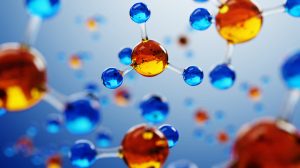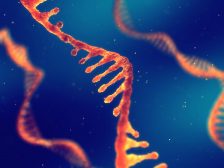Table of Contents
Ribonucleic Acid Definition
noun
(uncountable), ribonucleic acids
ri·bo·nu·cle·ic ac·id, raɪboʊnjuːkliːɪk ˈæsɪd
A nucleic acid that is frequently single-stranded and folded onto itself, and composed of repeating nucleotide units of ribose sugar, phosphate group, and nitrogenous base
Abbreviation: RNA. Synonym: ribose nucleic acid.
Overview
A nucleic acid refers to any of the group of complex compounds made up of linear chains of monomeric nucleotides. Each nucleotide component, in turn, is made up of phosphoric acid, sugar, and nitrogenous base. Nucleic acids are involved in the preservation, replication, and expression of hereditary information. Two major types of nucleic acids are deoxyribonucleic acid (DNA) and ribonucleic acid (RNA).
History
The discovery of nucleic acids was credited to the Swiss physician and biologist, Friedrich Miescher 1844 –1895, in 1868. He was able to isolate a biological molecule that was neither a protein, nor a carbohydrate, nor a lipid from the nuclei of white blood cells. He named the compound nuclein based on where he derived it from.1 The acidic properties of the compound were discovered by the German chemist, Albrecht Kossel 1853 –1927. Later, nuclein was replaced with nucleic acid; the term was coined in 1889by the German pathologist, Richard Altmann 1852 –1900.2 The nuclein discovered by Miescher was later particularly identified as DNA. During the early 1900s, there was no clear distinction between DNA and RNA. Both were simply referred to as nucleic acids and were named from where they were isolated. For instance, RNA was initially called the yeast nucleic acid. Eventually, RNA was found to be different from DNA based on the difference in the two’s sugar component: RNA has ribose sugar whereas DNA has deoxyribose. Moreover, RNA has uracil in place of thymine in DNA. Francis Crick (who together with James Watson was credited for their double helical model of DNA) proposed the Central Dogma of Molecular Biology. Accordingly, DNA leads to the formation of RNA, which in turn leads to the formation of protein. In the years thereafter, RNA types involved in protein synthesis were identified, such as messenger RNA (mRNA), transfer RNA (tRNA), and ribosomal RNA (rRNA).
Structure
Ribonucleic acid (RNA) is a molecule consisting of a long linear chain of nucleotides. Each nucleotide unit is comprised of a ribose sugar, a phosphate group and a nitrogenous base (also called nucleobase). Ribose is a pentose sugar whose carbons are numbered 1′ through 5′. The phosphate group is connected to the 3′ of the ribose and the 5′ of another ribose. The nitrogenous base is connected to the 1′ of the ribose. The ribose sugars and the phosphate groups make up the backbone of the RNA. The nitrogenous bases of the RNA are, in general, adenine (A), cytosine (C), guanine (G), and uracil (U).
DNA vs RNA
DNA is a double-stranded nucleic acid containing the genetic information of a living thing. It is essential for the cell growth, division, and function of an organism. RNA is a single-stranded nucleic acid except for some viral RNAs and siRNA that are double-stranded. Below is a table that summarizes the major differences between DNA and RNA.
| DNA | RNA | |
| Structure | DNA is composed of two strands that twist together to form a helix, forming a ladder-like structure. Each strand consists of alternating phosphate (PO4) and pentose sugar (2-deoxyribose), and attached on the sugar is a nitrogenous base, which can be adenine, thymine, guanine, or cytosine. In DNA, adenine pairs with thymine and guanine with cytosine. Not all DNAs are double-stranded. For instance, a group of viruses have single-stranded DNA genome. | RNA consists of a long linear chain of nucleotides. Each nucleotide unit is comprised of a sugar, a phosphate group and a nitrogenous base. It differs from DNA in having ribose as its sugar, (deoxyribose in DNA) and the bases are adenine, guanine, cytosine, and uracil. In RNA, adenine pairs with uracil and guanine with cytosine. RNAs are single-stranded except for certain viruses whose genome consists of double-stranded RNA. |
| Location | In eukaryotes, most DNAs are located in the nucleoli and chromosomes in the nucleus. A small fraction of the total DNA is present in mitochondria, chloroplasts, and cytoplasm. In prokaryotes and viruses, DNA is found in the cytoplasm. | In eukaryotes, RNA is found in the nucleus and in the cytoplasm. In prokaryotes and viruses, it is found in the cytoplasm. |
| Function | DNA is a long polymer of nucleotides to code for the sequence of amino acid during protein synthesis. DNA carries the genetic ‘blueprint’ since it contains the instructions or information (called genes) needed to construct cellular components like proteins and RNAs. | In some viruses, RNA is the genetic material. For most organisms, RNAs are involved in: protein synthesis (e.g. mRNA, tRNA, rRNA, etc.), post-transcriptional modification or DNA replication (e.g. snRNA, snoRNA, etc.), and gene regulation (e.g. miRNA, siRNA, tasiRNA, etc.). |
RNA types
RNA may be classified in many ways. For instance, RNAs may be classified based on the length of the chain: small RNA vs. long (or large) RNA. Small RNAs are those comprised of about 200 or fewer nucleotides. Long RNAs are those consisting of more than 200. Examples of small RNAs are transfer RNA (tRNA), 5S ribosomal RNA (rRNA), microRNA (miRNA), small interfering RNA (siRNA), small nucleolar RNA (snoRNA), Piwi-interacting RNA (piRNA), tRNA-derived small RNA (tsRNA), and small rDNA-derived RNA (srRNA). Examples of long RNAs are ”long non-coding RNA (lncRNA) and messenger RNA (mRNA).
mRNA is an example of RNA that codes for a protein. It is translated into a protein based on the genetic information it copied from the DNA. A non-coding RNA (ncRNA) is an RNA that is not translated into a protein. RNAs that do not code for a protein include tRNAs, rRNAs, microRNAs, siRNAs, piRNAs, snoRNAs, snRNAs, exRNAs, scaRNAs, and lncRNAs.
mRNA
In prokaryotes, mRNA is produced by splicing a large primary transcript from a DNA sequence. The mRNAs of prokaryotes are usually very short lived (from seconds to more than an hour) and protein synthesis starts even while the mRNA is still being synthesized. The resulting mRNA is essentially mature upon transcription and requires no extensive processing. In eukaryotes, the mRNA is produced in the nucleus (during transcription). This mRNA needs to be processed extensively to become mature. This extensive processing includes the following steps: (1) addition of a 5′ cap at the 5′ end and a sequence of adenylate groups at the 3′ end – the poly a tail, (2) the removal of any introns, and (3) the splicing together of exons. When the pre-mRNA has been completely processed, it is now called a mature mRNA, which will then be transported for translation into the cytoplasm through the nuclear pore. The eukaryotic mRNA has relatively longer lifespan, e.g. mammalian mRNA can live from several minutes to days.
tRNA
Transfer ribonucleic acid or tRNA is the RNA that transports the specific amino acid to the ribosome to be added onto the growing chain of amino acid. tRNA molecule has these two important regions: (1) trinucleotide region containing the anticodon and (2) attachment site for a specific amino acid.
rRNA
Ribosomal ribonucleic acid (rRNA) is a ribonucleic acid that, together with proteins, makes up the ribosome. A ribosome is a cytoplasmic particle that serves as the site of protein synthesis. It has three binding sites: A, P, and E sites. The A site binds to tRNA with an amino acid (called aminoacyl-tRNA). The P site is the site in a ribosome occupied by tRNA carrying the growing peptide chain (i.e. peptidyl tRNA). The E site is the site for decylated tRNA on transit out from the ribosome.3 Ribosomal RNA does not carry the code in making proteins. Rather, it forms the two subunits (i.e. large subunit and small subunit) that make up a ribosome. The large subunit serves as a ribozyme that acts as an enzyme. As an enzyme, it catalyzes the peptide bond formation between two amino acids.
Common biological reactions
RNA synthesis
RNA synthesis occurs via transcription, a process wherein a segment of DNA is copied as catalyzed by the enzyme RNA polymerase. The enzyme binds to the promoter sequence of the DNA molecule. The enzyme helicase unwinds DNA and the RNA polymerase, then, progresses along the DNA strand in the 3’ to 5’ direction. In eukaryotes, the newly formed RNA undergoes maturation, e.g. by the addition of a poly(A) tail and a 5’cap and then by the removal of introns via the action of the spliceosome. In certain viruses, new RNA forms using RNA as the template and RNA-dependent RNA polymerase as the enzyme.
RNA degradation
The degradation of nucleic acids like RNA yields purines, pyrimidines, phosphoric acid, and a pentose, either D-ribose or D-deoxyribose.
Protein synthesis
Protein synthesis is comprised of two processes, i.e. transcription and translation. Transcription is the process in which messenger RNA (mRNA) is produced based on a DNA template. The mRNA moves from the nucleus to the cytoplasm to reach the site of protein synthesis, the ribosomes. In the ribosome, translation occurs. It is when the amino acids will be joined together in a particular order as specified by the genetic code conveyed by the mRNA.
Transcription
DNA carries the genetic information that codes for a particular protein. Thus, in order to synthesize a protein, the genetic code for it has to be copied first into the mRNA. This process of creating a copy of DNA into mRNA through the help of the enzyme RNA polymerase is called transcription. Although RNA polymerase traverses the DNA template strand from 3′ → 5′, the coding (non-template) strand is usually used as the reference point. Hence, the process proceeds in the 5′ → 3′ direction, like in DNA replication. However, unlike DNA replication, transcription does not need a primer to start. And in place of thymine, uracil pairs with adenine. In prokaryotes, transcription occurs in the cytoplasm whereas in eukaryotes it takes place primarily in the nucleus. Then, the mRNA transcript is transported into the cytoplasm for translation or for protein synthesis.
Translation
Translation is a step in protein biosynthesis wherein the genetic code carried by mRNA is decoded to produce the specific sequence of amino acids in a polypeptide chain. The process occurs after transcription (whereby the DNA sequence is copied or transcribed into the mRNA. Translation occurs in the cytoplasm where the ribosomes are located. It consists of four phases:
(1) Bioactivation, i.e. the correct amino acid is covalently bonded to the correct tRNA – a step required for translation to proceed
(2) Initiation, i.e. the small subunit of the ribosome binds to 5′ end of mRNA with the help of initiation factors (IF)
(3) Elongation, i.e. the next aminoacyl-tRNA in line binds to the ribosome along with GTP and an elongation factor.
(4) Termination, i.e. the A site of the ribosome faces a stop codon (UAA, UAG, or UGA)
During translation, the ribosome traverses each codon and pair it with a specific amino acid linked to a tRNA.
Biological importance
RNA has a major role in the following biological reactions: (1) protein synthesis, (2) post-translational modification or DNA replication (snRNA, snoRNA, etc.), and (3) gene regulation (e.g. miRNA, siRNA, tasiRNA, etc.) In certain entities like RNA viruses, their genetic material is RNA. Some of the medically-important RNA viruses include ebolaviruses (causative agent of Ebola), SARS coronavirus (causing SARS), lyssaviruses (causing rabies), rhinovirus, (causing common cold), measles virus, influenza virus (causing flu), and Morbillivirus sp. (causing measles).
RNA, specifically rRNA, can be used as basis in taxonomy and evolution. Ribosomal DNAs, which are the genes coding for rRNAs, are sequenced in order to identify the taxonomic group of an organism as well as estimate the rate of species divergence.
RNA world hypothesis
RNA world hypothesis holds that primitive life might have been RNA-based since RNA could be both a genetic material and a catalyst. The transitioning of primitive life forms into single-celled living things occurred gradually for many million years.The RNA-based life likely dominated the primitive Earth and served as the descendants of the present-day living organisms. How RNA came into being is conjectured to come from, and synthesized in, the asteroids from the outer space. They probably reached the Earth through meteorites. NASA reported that they found RNA and DNA nucleobases (e.g. adenine, guanine) in meteorites.4 They could have led to the spontaneous creation of RNA and DNA on Earth.
Related terms
- Acceptor rna
- Chromosomal rna
- Heterogeneous nuclear rna
- Informational rna
- Masked messenger rna
- Messenger rna
- Messenger-like rna
- mRNA
- Nuclear RNA
- Ribosomal RNA
- Ribozyme
- Rna 2-o-methyltransferase
- Rna 3-terminal phosphate cyclase
- Rna polymerase
- rRNA
- Satellite rna
- Sisomicin-gentamicin resistance ribosomal rna meth
- tRNA
- Ui rna
Compare
See also
Reference
- “nucleic acid”. (2014). Retrieved from www.nature.com/scitable/definition/nucleic-acid-274
- Gribbin, J. (2002). The Scientists: A History of Science Told Through the Lives of Its Greatest Inventors. New York: Random House. p. 546. ISBN 0812967887.
- A-site, P-site and E-site. Retrieved from ://www.nobelprize.org/educational/medicine/dna/a/translation/epa.html
- NASA – NASA Researchers: DNA Building Blocks Can Be Made in Space. (2011, January 1). Retrieved from www.nasa.gov/topics/solarsystem/features/dna-meteorites.html
© Biology Online. Content provided and moderated by Biology Online Editors


